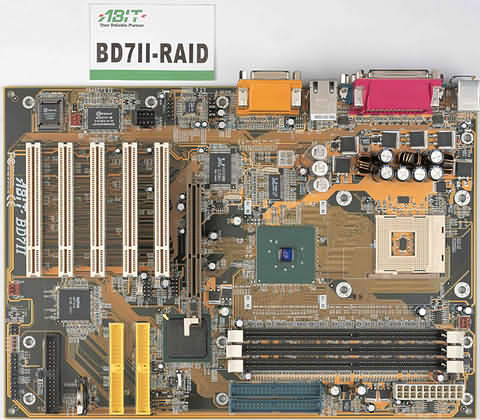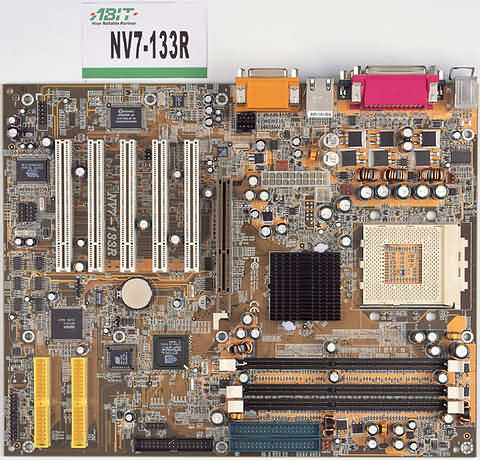 |
||
|
||
| ||
ABIT had a huge exposition at CeBIT 2002 Show. But in order to look at the new products objectively let's dive into the history.  ...Several years ago the SoftMenu technology allowed ABIT to surpass all its competitors in making mainboards for overclockers - the most self-sacrifying enthusiasts who are first to vote with their purses for innovative technologies which help them to squeeze the most of their PCs. What was SoftMenu for each of us? For some people it was a carryover of all settings of a processor frequency and memory into BIOS where all changes could be made without opening the system block, for some the most important thing was a possibility to change a system bus speed in just 1 MHz steps, and the rest might remember how their processors were balancing on the verge of a death running at the voltage higher than the rated one by just several tenth of a volt... That trick helped the company to strengthen its position on the DYI (Do it Yourself) market and allowed it to establish such prices which other motherboard makers couldn't even dream of. Moreover, the SoftMenu technology was the largest achievement of the company, but I don't think its golden days are over. On the one hand, a solid breakthrough was done when the company established close relations with the leader of the graphics accelerator market - NVIDIA, and started production of accelerators on the latest GeForce4 MX and GeForce4 Ti chips. There were no delays in supplying of new cards onto the market - at least ABIT did it not later than the others. On the other hand, amalgamation of HP and Compaq was a tough blow. In the middle of the last year ABIT made a contract with Compaq for supplying Barebone systems for Pentium III, and later for Pentium 4 processors. But after the two companies had teamed up model rows and lists of supplies were reconsidered. Besides, there were problems with mainboards. It was a mistake to release an entire line on the AMD760 chipset and ignore the VIA KT266. In the beginning everything was good - in some applications the AMD760 outperformed its competitor and a solution with 4 DIMM slots which was offered only by ABIT promised wonders. But when the KT266A came onto the market, all efforts of ABIT were mocked, and the problem was not only that the KG7 boards weren't in demand anymore, but the time was lost - the other companies just replaced the north bridge with the more advanced one, and ABIT had to develop KR7A boards from the very beginning. But we must give ABIT its due - the boards turned out to be brilliant, they have the highest overclocking frequencies, more than average functionality, and a performance at the leaders' level. However, the boards appeared too late and were overpriced. But ABIT is not going to accept such state of affairs - the engineers have developed a conception which in case of a warm welcome can make a small revolution on the mobo market.  This is ABIT MAX. With this technology supported a board gets rid of all legacy interfaces because they are old and unable to support entirely new specifications -- plug'n'play, hot plug, etc. (including COM, LPT & PS/2) and get high-speed ones (Firewire, USB2.0, SmartCard, CompactFlash, MemoryStick, SD - the 4 latter are supported via a special 5" device on the front panel a bit similar to a SmartCard Reader), and secondly a board incorporates additional controllers - 6-channel sound with all unsoldered inputs and outputs and even with an optical input/output, 4-channel IDE RAID HPT374 controller of HighPoint, network, USB2.0, Firewire etc. So far the company has released only two boards complying with the MAX conception - AT7 on the latest VIA KT333, and IT7 on an Intel's chipset, which hasn't been announced yet, with the 533 MHz bus support.  ABIT AT7 Mainboard Specification of the ABIT AT7 Mainboard:
 ABIT IT7 Mainboard Specification of the ABIT IT7 Mainboard:
Have your already calculated how much it can cost - $200-250? Of course, ABIT products have always been expensive but there are not many users ready to spend such a heap of money, especially considering that a 5" unit for reading of cards must be bought separately. Besides, upgrade of old keyboards and mice to new ones with the USB interface will add $25-50. Combination of Hi-End and total integration reduces this drawback but note that one of the boards has 4 PCI slots and the other just 3. The situation ABIT is in is quite complicated, and the company is rather far from Intel which is a locomotive of the IT market. Whether ABIT will be able to break the stereotypes the company doesn't know itself, and that is why they have also released several usual boards on new and not very new chipsets. Here are some other new boards shown off at CeBIT:  ABIT SX7-533 Mainboard Specification of the ABIT SX7-533:
 ABIT BD7II-RAID Mainboard Specification of the ABIT BD7II-RAID:
 ABIT NV7-133R Mainboard Specification of the ABIT NV7-133R:
As you can see, ABIT keeps up with its competitors: it has added ATA133 RAID and USB2.0 support and provided the maximum number of overclocker-friendly features. Well, ABIT has some prospects, and one of them
is to take a solid share on the video card market; fortunately,
Gigabyte went to ATI. If the MAX becomes a success, then it will
be a second revolution of ABIT...
Write a comment below. No registration needed!
|
|
Platform · Video · Multimedia · Mobile · Other || About us & Privacy policy · Twitter · Facebook
Copyright © Byrds Research & Publishing, Ltd., 1997–2011. All rights reserved.